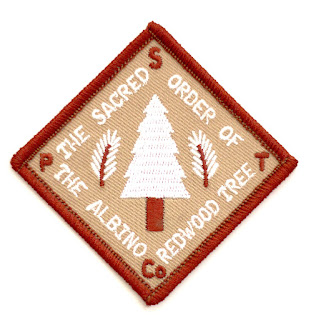ALBINO REDWOODS
The San Perdido Trading Company is proud to offer this handsome "Sacred Order of the Albino Redwood Tree" embroidered patch. It is our salute to one of the rare natural wonders of the forests of California. And YES: albino redwoods actually do exist.
You may be wondering how a tree (which uses chlorophyll to turn sunlight into food) can survive with no chlorophyll (and thus having snow white or yellow needles instead of green). Simply put, it survives with the help of its neighboring redwoods; Redwood Trees (Sequoia sempervirens) have the habit of grafting their roots onto their neighbors'. This means that they share food and fluids with neighboring redwoods through their roots. In the case of a redwood which has a mutation which prevents it from creating chlorophyll, it is being fed by its neighbors.
This relationship is not entirely one-sided (not entirely parasitic): albino redwoods tend to have broken stomata (the microscopic holes plants use to exchange gasses [to "breathe"]) which causes them to lose more water. The net result of this is that albino redwoods function like kidneys for the neighboring trees: they absorb more water and thus accumulate and store toxic heavy metals which would otherwise remain in the soil.
473 albino redwoods have been documented so far, but likely hundreds more exist in remote areas. The largest concentrations in public areas are at Henry Cowell State Park (near the San Francisco Bay Area) and Humboldt Redwoods State Park (in northern California). As you can imagine, the locations of most albino redwoods are kept secret, to prevent them from falling prey to souvenir hunters.
Large albino redwoods (beyond 20-30ft high) are exceedingly rare, perhaps because there is a limit to the nutrients they can "borrow" from neighboring trees, and perhaps because of their habit of absorbing toxic heavy metals from the soil and water which may eventually take a toll on the tree.
We're excited about "Chimera Redwoods" - a team dedicated to the research and preservation of albino redwoods. And the epic bonus round: they will have "chimera" albino redwood seedlings (part green [normal] and part albino [mutant]) for public sale in 2019. Their patented "Mosaic Delight" albino redwoods are not taken from cuttings of wild redwoods, but were developed via greenhouse experiment. Looking forward to 2019!





Comments
Post a Comment